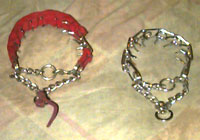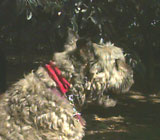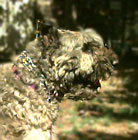
disguised pinch collar (left) and normal pinch collar (right)
IN PRAISE OF THE PINCH COLLAR |
This article describes the use of the "pinch collar", a training tool that is often misunderstood and often rejected for the wrong reasons. Properly understood and properly used, it can be a wonderful tool, especially for dogs who are strong and not very sensitive with handlers who are not enormously strong physically.
I wrote this in 1991, when halters were just beginning to appear and were not well understood (and I certainly had never used one) . Today in 2003, in some of the situations in which I would previously have used a pinch collar, I now would find a halter ("Halti" or "Gentle Leader" or "Snoot Loop") to be more advantageous, especially for those handlers who cannot train themselves to keep the leash loose at all times except when actually correcting.
Further updates in 2007, giving warnings against improper use. As of 2007, I find that I use the halter for 90 to 95% of my foster dogs, but the pinch collar is still an essential tool for those few who do not respond well to the halter.
I do NOT discuss any of the various anti-pull harnesses, of which there are a variety of designs. I have not used these. I observe varying success for others using them. When I refer to "body harness" in this article, I do not mean any of those intended to counter-act pulling. I refer to those that are intended to allow pulling and/or are used because the dog's neck problems counter-indicate use of a collar and/or are used in car travel attached to a seat-belt.
| SITE INDEX | BOUVIER | RESCUE | DOG CARE |
| PUPPY REARING | TRAINING | PROBLEMS | WORKING DOGS |
| BOOKS | VERSE | IMAGES | MISCELLANEOUS |
The pinch collar is a much misunderstood , and therefore misused and underused , tool which can be of genuine value to the dog trainer. I believe that the cause of the misunderstandings lie partly in the appearance of this implement and partly in the names by which it is generally known, but mostly in a lack of thought about the relationship between this implement and that used by that supremest of all dog-trainers , the mamma-bitch.

Most people assume that the pinch collar works as a negative reinforcer or as a punishment because it causes a sensation of pain. Those who can't stand the thought of inflicting pain on their beloved dog therefore refuse to use a pinch collar. Those who see their dog as a willfully disobedient and defiant adversary or those who are angry with the dog, those who have for the moment forgotten their love for their dog, are often too willing to use pain as a motivator and assume the more the better, thus use the pinch collar harder than necessary, often with adverse results. Those who love their dog but recognize that the contrast between pleasant and unpleasant results of the dog's right or wrong response to a given stimulus greatly aid the dog in learning will generally read their dog well enough to use a pinch collar well, even though they believe that it works because it hurts.
It is my belief that the true power of the pinch collar is the similarity in the sensation it makes when popped and released to the sensation made by the mamma-bitch briefly grabbing the whelp by the neck with her teeth. Thus the impact on the dog is through his social psychology by making the statement " I , your mother, don't approve of your behavior", rather than through his self-preservation psychology by causing pain. Since the bitch rarely bites the puppy's neck very hard , it should not be necessary to give more than a moderate pop on the pinch collar, and indeed for the most part I find that a light to moderate "pop" is all that is needed. Only if the dog is quite excited with his attention intensely focused on some object or activity, thus dull to perceiving other sensation, would a stronger jerk be needed in order for the dog to notice it and respond. Thus an appropriately guaged pop will gain the dogs respect for the leadership of his handler and will impress him that the behavior in which he was engaged is disapproved, but it should not make him feel fearful. I hope the recognition that one does not necessarily need to inflict severe pain on the dog will encourage those of you who have heretofore been unwilling to use this useful device to try it --- especially if your training mentor advises you to do so and is willing to supervise your first few attempts.
In line with this "sensation of mamma's teeth" theory, we might also put this quality to work when we give a scruff shake or a muzzle-surrounded-by-hands type of rebuke by including a bit of poking or pinching sensation from our fingernails to simulate the teeth of the bitch. ( Those who bite their nails are out of luck.) Those who use any of the muzzle-constriction halter-like devices sold under various names ("Halti", "Kumalong") are also utilizing a mamma-bitch rebuke and could emphasize this (if needed) by putting a few blunt rubber nubs on the inner surface of the noseband.
(Update : "Kumalong" seems to have dropped by the wayside, but the "Halti" has become popular and the halter formerly known as "Promise" and now known as "Gentle Leader" has become popular. Today everyone advocating the use of halters proclaims that the psychological basis is the communication of social dominence, ie the mamma-bitch message and the pack-leader message, telling the dog to relax and be subordinant and follow the leader's cues.)
There's little doubt that the appearance of the pinch collar, looking very barbaric , causes many people to believe it must be an instrument of torture. Those who know better may still be unwilling to use one in public because they fear the disapproval of those who see this ugly contraption and believe it to be an implement of torment. Well, there's an easy answer : camouflage. You could tie a bandanna over the pinch collar, which looks quite jaunty and is considered stylish by some. You could stitch a wide flat band of leather or fabric to the outside of the pinch collar. My own answer (illustrated below) has been to flatten the links slightly and slip the collar inside a length of 2" wide tubular nylon webbing (from the camping store), then poke the prongs through the inner surface of the webbing. The sole disadvantage of the latter two methods is that they make it difficult to shorten the collar by removing links; one can still add links easily to lengthen it. Now any experienced dog trainer will quickly spot a camouflaged pinch collar and smile knowingly; but the non-dog training ignorant member of the public will never guess. Those matches that forbid use of pinch collars will generally forbid a camouflaged pinch, even though the reason given for the prohibition is "well, we are in a public place and so we have to think about the way we appear to the general public". (Note : halters are also disallowed at AKC events. The rationale for this is totally unclear to me.)
photos of the collar on the dog (thank you, Grover)
 disguised |
 undisguised |
(Update 2003 : interestingly those who use a halter often find that members of the ignorant general public look at it and think it is a muzzle and tht therefore the dog waring it must be a dangerous biter. So much so that "Gentle Leader" sells a button one can wear on one's shirt that procalims "It's NOT a muzzle !" Of course many who use halters welcome the chance to educate others as to what they really are. As these tools have become more popular, the public recognition of them as a pleasant means of dog-control has increased.)
(update 2017 : even now not everyone understands that "it's not a muzzle". On a Judge Judy episode, she insists that a halter IS a muzzle and thus indicates that the owner was aware the dog could be aggressive. (Of course if your dog really is apt to aggress under some sets of circumstances , eg the vet's waiting room, use of a real muzzle would be a true example of appropriate care to prevent possible harm.) )
The names "pinch collar", "prong collar", and "spike collar" certainly tend to foster the belief that the collar operates by means of pain. These names discourage many people who need such a collar to control a strong or unruly dog from using them.
Many shrewd training class leaders have recognized this and therefore refer to this tool as a "power steering" collar or as "the equalizer". These names seem to help to make those who need this tool more willing to use it. Such names imply that the handler is using it to compensate for his relative lack of physical strength as compared to the dog --- which indeed is often true for many women and slightly-more-than-middle-aged persons when dealing with a healthy and exhuberant young Bouvier or Rottweiler. Still the implication is that the collar operates in the realm of the physical, rather than the psychological, and so fails to emphasize the concept of the mamma-bitch.
Let me suggest to those looking for another name for our friend the pinch collar that they might well refer to it as the "mamma-bitch" collar or the "listen to me , I am your Mother !" collar.
Yea, verily, if thou woulds't train thy dog , thou shoulds't go to the bitch : consider thou the ways of the mamma-bitch and emulate her !
As mentioned above, nowadays (2007) I almost always try the halter first and only go to the pinch collar if the dog does not respond well to the halter. So probably 90 to 95% of my foster dogs are worked on the halter and only about 5% need the pinch collar and maybe 5 to 10% would be just fine on a flat (non-slip) collar. I don't seem to use an ordinary slip-chain (mis-named "choke chain") very much anymore, though I will switch to it when preparing a dog for some test or competition in which halters are not allowed (and of course pinch collars also not allowed) but slip chains permitted, and the dog needs more than a plain flat collar. For some types of event, eg Agility and French Ring, the rules specify the dog may not even wear a collar, and for herding events if the stock has horns I consider any kind of collar to be a potential safety hazzard ; so for such events my dogs go naked. (I'm glad there are no events for which rules or safety require that I appear naked --- and no doubt the spectators are even more grateful for this !)
But I still have my pinch collars and still find them tremendously helpful once in a while. Likewise I still have occasions to recommend the pinch collar to someone else.
(Update 2017 : all my current dogs are on halters except for Velvet, who is off leash (rural walks) or on flat collar, and Fox The Wicked Queensland , who wants to bite truck tires and can leap in wild gyrations if on a halter (risking injury to herself), much more responsive to pinch collar, and who will sit and wait for tossed treats if I see the approaching vehicle soon enough.)
To use a pinch collar correctly you the handler have to be habitually sure to put slack into the leash whenever the dog is behaving appropriately. If you create a pull, the dog will pull back and can injure himself as well as becoming more and more of a puller.
To give a correction with the pinch collar, you must first throw some slack into the leash and then give a quick pop or jerk of degree appropriate to the dog, ie enough to get the reaction you want, and then immediately loosen the leash again. If you have to give a series of corrections, you must have each pop come out of a loose leash.
Trainers : it can be very hard to get some people into these essential leash handling habits. Those who cannot learn to give loose leash every second the dog is behaving properly will not be able to use a pinch collar or a slip collar effectively. They may get better result with a halter, although for best result that tool too should be used with leash loose every moment the dog is behaving.
Trainers : be sure to teach your students how to fasten and unfasten the pinch collar. It is far from being obvious to most people how to do this. I had one unfortunate situation where I failed to ensure that the adopter of a dog knew how to take the collar off, witht he result that she left it on all the time until it started digging into the poor dog's flesh, at which point she did have the wit to use a bolt-cutter to cut through the metal links. My fault, not hers.
Some years ago a vet did a study of the long term use , ie chronic use, safety of pinch collars as compared to slip-chain ("choke chain")collars. This vet was able to do necropsy studies on the necks of a number of dogs who had been in obedience training and competition for many years (I'd assume these were dogs whose handlers were seeking OTCh titles). So these dogs had many years of repeated corrections with the collar. Surprisingly the vet found that the pinch collar dogs showed considerably less damage to their necks (windpipe , larynx, esophagus) than did the slip-chain dogs. That would be a pretty good arguement for using a pinch , using it as lightly as possible of course, rather than a choke chain. Of course when mis-used, this tool like any other tool can be quite dangerous or even deadly. See the next section below.
Pinch collars are NOT SAFE to use with strong jerks or a strong sustained pull ! The same is true of slip-collars (unlimited slip) and can be true of limited-slip collars as well.
There is an obvious danger of injury from sustained hard pulling.
A hard jerk on a pinch collar also has the potential for injury.
Pinch collars are NOT SAFE for dogs with some medical conditions :
Do NOT leave a pinch collar or slip-collar of any kind on a dog when the dog is not under human supervision, and especially do not do so with any kind of line or leash attached. If the collar or leash were to get caught on something and especially something overhead, injury or strangling (death) might result. Although the pinch collar, being a limited slip type of collar, is somewhat less dangerous than the standard "choke chain" unlimited slip collar, it's way too much risk to take unless of course you have a dog whose behavior problems are so severe that the need to be able to take control through the attached line outweighs any risk to the dog. The main time when leaving a pinch collar and short tab leash on a dog would be worth the risk would be when dealing with a dog with aggression (to humans) issues or one who tends to jump up on people vigourously (which can be more dangerous than a bite if the person falls and breaks a hip).
Do NOT use a pinch collar or any other pain-to-neck device (including especially a bark-corrector or remote shock collar) on any dog with a dog-to-dog aggression problem. Pain tends to increase aggression. For dog-aggressive dogs, any pain in the neck can trigger the same fight response as would be triggered by being bitten in the neck by the other dog. So use of neck pain to a dog who is dog aggressive is likely to cause the dog to start a fight as a pre-emptive strike under less and less provocation from the other dog. Additionally, if a pinch collar or chain collar is on a dog who is grabbed by the neck by another dog, the grabbing dog may catch and break a tooth on it, which causes great suffering to that dog and great expense to whoever has to pay for a root-canal procedure.
Related topics :| site author Pam Green | copyright 2003 |
| created 1991 | revised 7/05/07, 3/16/2017 |
| return to top of page | return to Site Index |